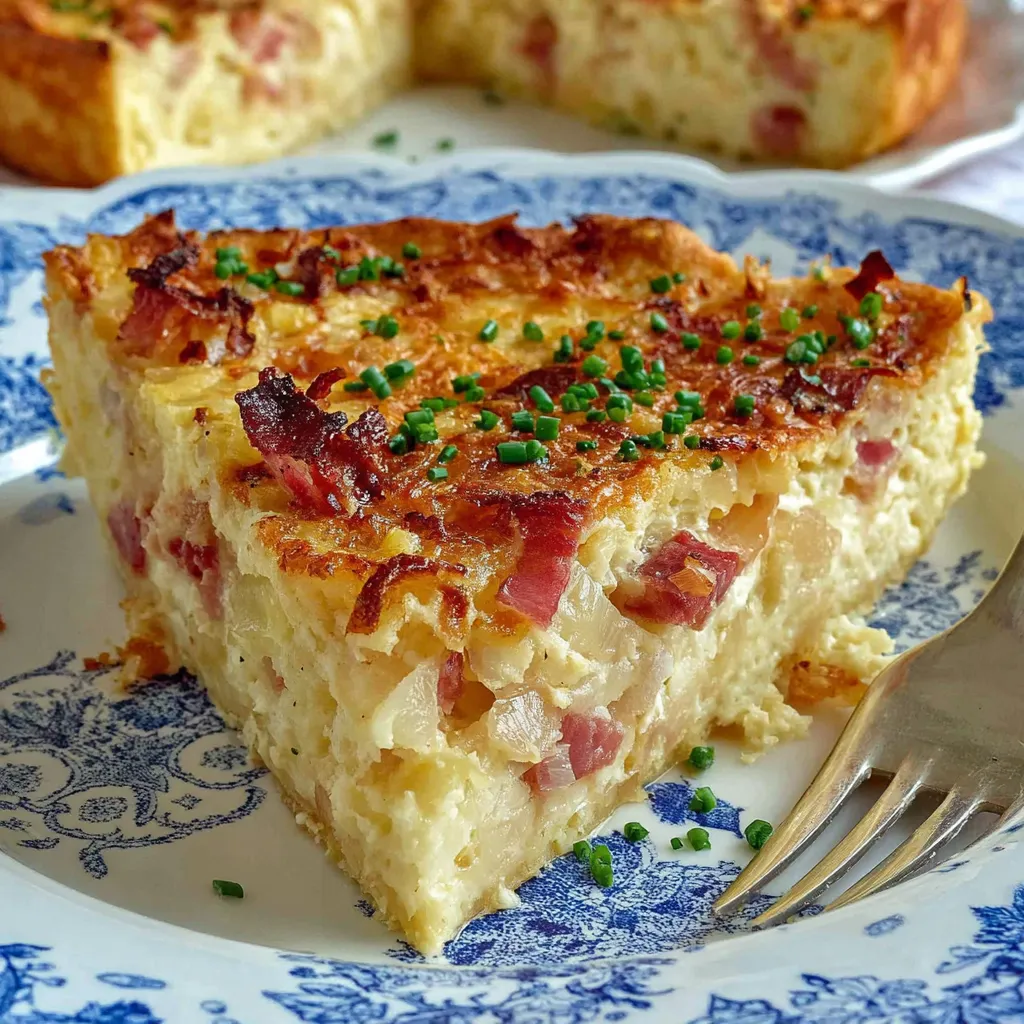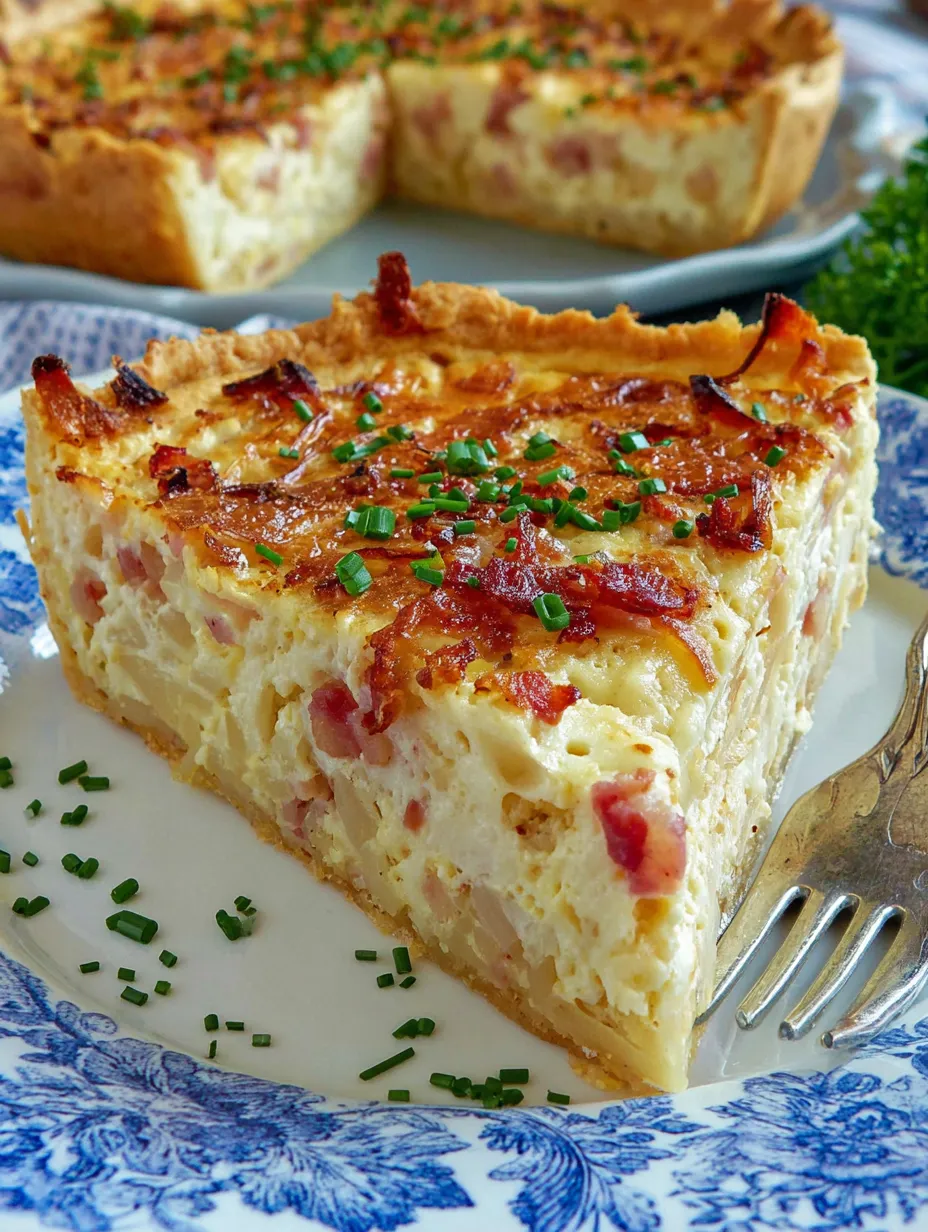 Save
Save
Authentic Zwiebelkuchen is that irresistible German onion cake that fills the whole kitchen with sweet slow-cooked onions and smoky bacon. It is perfect as a main dish or a hearty snack and always reminds me of autumn markets in Germany. This recipe is how my family celebrates comfort food season and every time I bake it for friends they go home with the printed recipe tucked in their pocket.
I baked this first for an Oktoberfest dinner and have been asked for it every year since. The scent alone gathers everyone at the table and it also keeps beautifully for days.
Ingredients
- Lukewarm milk: brings the yeast to life and gives the dough its tender crumb look for milk just above room temperature not hot
- Sugar: helps activate the yeast use regular granulated sugar for the best result
- Instant yeast: ferments the dough and creates fluffiness check that the packet is within date for the best rise
- Salt: seasons the dough and balances flavor use fine sea salt if possible
- Flour: builds structure and chewiness German type 405 or all purpose flour works both give a nice soft bite
- Vegetable oil: keeps the crumb moist any neutral oil is fine but pick a fresh one without odor
- Onions: form the sweet base of the filling go for firm heavy onions with tight papery skins
- Smoked bacon: adds savory depth and smokiness I love a thick cut bacon with few ingredients on the label
- Extra vegetable oil: helps caramelize bacon and onions again choose a clean tasting oil
- Ground caraway seeds: give a hint of earthy spice whole caraway works too or skip it if you are not a fan
- Sour cream: gives creaminess and tang try to use full fat for the richest result
- Eggs: bind the filling and add silkiness check for fresh eggs with bright yolks
- Salt and pepper: make every bite pop use freshly cracked black pepper for oomph
- Chives for garnish: add great color pick bright green fresh bunches if using
Step-by-Step Instructions
- Make the Yeast Mixture:
- Pour lukewarm milk into a bowl and stir in the sugar and instant yeast. Let it rest about ten minutes until bubbles form on the surface which means your yeast is active and ready.
- Prepare the Dough:
- Combine flour and salt in a large mixing bowl. Pour in the milk yeast mixture and add the oil. Using a stand mixer or a sturdy hand mixer with a dough hook knead for at least five minutes until the dough is smooth elastic and pulls away from the bowl.
- First Rise:
- Lightly grease a large bowl with oil. Place the dough in the bowl turning it once so the surface is coated. Cover and leave in a warm spot for about forty five minutes until doubled in size.
- Cook Onions and Bacon:
- Peel the onions and slice them into thin rings for even cooking. Dice the bacon into small cubes. Heat a large frying pan with a splash of vegetable oil over medium heat and cook bacon until crispy and browned. Add onion rings and cook slowly over low to medium heat for about ten minutes stirring often until onions are translucent and naturally sweetened. Do not rush this step.
- Mix the Filling:
- Set the onion and bacon mixture aside to cool briefly. In a separate bowl whisk the sour cream and eggs until smooth. Stir this into the cooled onions and bacon then add ground caraway if using. Season the filling to taste with salt and black pepper.
- Shape the Base:
- Flour your work surface and knead the risen dough by hand a minute to press out any large air bubbles. Roll out into a rectangle large enough to fit your baking tray. Place it in an oiled or lined tray pressing the dough gently into the corners and up the sides to create a rim that holds the filling.
- Assemble and Bake:
- Preheat the oven to 200 degrees Celsius. Pour the onion mixture evenly onto the prepared dough base and smooth it out. Bake on the middle rack for about thirty five minutes until the filling sets and the edges turn golden brown.
- Cool and Serve:
- Let the Zwiebelkuchen cool slightly before slicing. Garnish with chopped chives for a burst of color and delicate onion flavor.

Onions are my favorite here because slow cooking them makes the house smell better than any candle and brings everyone into the kitchen. The first time my kids helped me stir the onions I knew it would become a family tradition and now it is a must for our Oktoberfest table.
Storage Tips
Zwiebelkuchen keeps wonderfully for up to three days in a sealed container in the fridge. For longer storage slice portions and freeze up to three months. To reheat thaw in the fridge and warm on a tray in a moderate oven for about five minutes which brings back the crispness of the crust.
Ingredient Substitutions
If you need to save time you can swap in ready made pizza dough or puff pastry for the homemade yeast dough. For a meat free version simply skip the bacon or swap it for sautéed leeks which add a similar depth. If you like a cheesy finish try sprinkling shredded gouda or cheddar on top before baking. For more herbal flavor you can add fresh thyme to the onions as they cook.
Serving Suggestions
I love Zwiebelkuchen for fall gatherings served with a crisp glass of Riesling or apple cider. It makes a great lunch with a green salad or a filling dinner when paired with soup. It is perfect for potlucks or to bring to a family get together since you can serve it warm or at room temperature.
Cultural Context
Zwiebelkuchen has a strong tradition in southwestern Germany especially during the grape harvest. In the fall people gather in wine taverns for new wine and a big tray of this savory cake. Each family has their own signature twist from added spices to extra creamy filling. Baking it always brings back cozy memories of cool weather and German markets.

Recipe FAQs
- → Can the bacon be omitted or substituted?
Yes, you can omit the bacon for a vegetarian option or replace it with leeks. Add extra cheese or your favorite vegetables for more flavor.
- → What type of flour works best for the dough?
Use Germany type 405, UK plain flour, or USA all-purpose flour. This achieves a tender, airy crust that's ideal for the base.
- → Is it possible to prepare the dough in advance?
Absolutely. The yeast dough can be made ahead, left to rise, and refrigerated overnight. Allow it to warm up before rolling out.
- → How should leftovers be stored?
Keep slices in an airtight container in the fridge and consume within three days. They can also be frozen for up to three months.
- → Can I use store-bought dough?
Yes, for convenience, substitute pizza dough or puff pastry as the base for quicker preparation and similar results.
